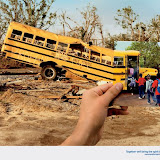
Zonne-energie onder de grond
Ieder jaar verbrandt de mensheid naar schatting 100.000 jaar aan fossiele zonne-energie. Want dat is in feite wat fossiele brandstoffen zijn: koolwaterstofverbindingen, ontstaan uit resten van plantaardig leven van tussen de 359 en 0,8 miljoen jaar geleden.
Het gevolg van deze verbranding is gekend. CO2 dat opgeslagen zit in deze brandstoffen komt ‘en masse’ vrij. Dat zorgt ervoor dat de koolzuurgasconcentratie in onze atmosfeer jaarlijks stijgt, en dat leidt tot klimaatsverandering.
Fossiele brandstoffen spelen echter een rol in alle mogelijke geledingen van onze economie. Transport, energie, voedselproductie, consumptiegoederen, kunststoffen, medische toepassingen, … er is geen enkel facet van onze economie denkbaar, of er komt petroleum, of oliegerelateerde producten bij te pas.
Het is ontzettend zonde om dit waardevol materiaal te verbranden.
Zonne-energie boven de grond
Ieder sprietje gras oogst zonne-energie op een veel eco-effectievere, efficientere en meer directe manier dan hoe wij het doen. Bovendien maakt het proces deeluit van het ecosysteem, en zet het zich daar niet buiten.
Door fotosynthese in het bladgroen wordt koostofdioxide omgezet in koolhydraten, en dat leidt tot een metabolisme dat niet destructief is maar constructief. Denk aan plantengroei. Denk aan waterzuivering. Denk aan voedselproductie en uitwisseling met andere soorten.
Als mens zijn we er nog niet in geslaagd dit metabolisme in haar totaliteit te kopiëren en toepassingen te vinden in onze eigen industrie en energieproductie. Maar met onze huidige zonnepanelen zijn we al halfweg, en weten we op een steeds meer rendabele manier zonlicht om te zetten in elektriciteit.
In feite zijn alle energiebronnen rechtstreeks of onrechtstreeks vormen van zonne-energie. Wind, getijden, golven, biodiesel, … De zon bestaat in feite uit kernfusie. Maar zelf kernfusie imiteren en daar energie uit oogsten, da’s een verhaal waar we voorlopig nog niet helemaal aan toe zijn.
Decentralisatie/ Power to the people
Een centrale energieproductie zoals een kerncentrale, en een one-to-many energiedistributie met een paar grote spelers paste perfect in het industriële efficiëntie-denken van de afgelopen eeuw.
Het blinkt uit op vlak van efficientie (volume), maar het is een systeem met weinig veerkracht (weerbaarheid voor wanneer iets mis gaat)
Maar mede dankzij de evolutie op het internet (2.0), de modelfunctie van het internet voor de ontwikkeling van een intelligent electricteitsnetwerk (the smart grid in de V.S), en de toenemende ‘do-it-yourself-mentaliteit’ in consumentenmarkten, wint het idee voor een gedecentraliseerde productie en distributie meer en meer terrein.
(Google transition towns)
Een interessant gevolg daarvan is dat enkel de energie geproduceerd en gedistribueerd wordt die nodig is, op de plaats waar ze nodig is, op de manier zoals ze plaatselijk het meest gebruik maakt van beschikbare bronnen zoals zee, zon of wind, voor-en-door de mensen die ze nodig heeft, enzovoort.
Infeite is de natuur zelf het beste model. De natuur beloont efficiënt gebruik en hergebruik, coöperatie (symbiose), diversiteit, succesvolle aanpassing aan lokale omstandigheden, … Bovendien draait de hele biosfeer (al wat leeft) op zonne-energie.
Marktsucces van het gedecentraliseerd model
In Nederland krijgen energieneutrale woonwijken steeds meer voet aan wal. De zuinigheidscultuur is daarbij een belangrijke succesfactor. Er bestaan uiteenlopende modellen, maar vaak zijn collectieve aankoop of bezit, financieringsproducten of inventieve product-service-combinaties de basis om daken van huizen allemaal te voorzien van zonnepanelen. Maar steeds vaker wordt er een energie-mix ontwikkeld bestaande uit een bonte symbiose van verschillende technologieën: energieproductie uit rioolwater, stadsverwarming uit asfalt, geothermische energie, etc…
Maar de meest opmerkzame groei van zonne-energie vinden we in Duitsland. Dankzij een fiscaal aantrekkelijke maatregel is Duitsland de grootste markt in de wereld voor foto-voltaïsche panelen. Het hele succesverhaal is schitterend in beeld gebracht in “Here comes the Sun”, door documentairemakers van de VPRO voor het duidingprogramma “Tegenlicht”.
http://www.youtube.com/watch?v=mLHBFyfvK8A
Een interessant rekensommetje
Opdat mensen of lokale gemeenschappen naast consumenten ook producenten zouden worden, zijn installaties nodig die geld kosten. Die investering is een drempel. Tenzij die vanaf moment één geld opbrengt in plaats van kost. Dat hebben enkele banken gedurende 2009 zeer goed begrepen, en hebben van zonn-energie een financieel product van gemaakt.
Een ander vooruitzicht is dat vanaf 2012 elektrische wagens onze wegen zullen veroveren. Ons bewustzijn van wat een ‘kilowattuur’ is, zal sowieso groter worden. Dan wordt dat zoiets als de benzineprijs aan de pomp.
Hoe maken we dit soort transitie succesvol?
Een nieuwe technologie of nieuw model is niet het enige wat nodig is. Er is ook een culturele innovatie nodig met een breed maatschappelijke draagvlak.
Ook moeten mensen hun dak gaan zien als een nuttige ruimte. In het verleden zijn slimme marketingstrategieën erin geslaagd om van een badkamer een welness-ruimte te maken, en om van een tuin een volwaardig bijkomende ‘living room’ te maken.
Met een dak moet herbestemming ook mogelijk zijn.
Waarom de Provincie?
De Provincies hebben een historische rol in de samenleving om oa. infrastructuren en diensten mogelijk te maken die de levensstandaard van burgers te verbeteren. Denk aan hun belangrijke bijdrage aan de distributie van drinkbaar water. Je staat er niet meer vaak bij stil, maar vandaag is stromend water een evidentie in de keuken en de badkamer, maar ooit was dat nieuw. Dankzij de provincie.
De provincie zou opnieuw deze maatschappelijke rol kunnen actualiseren en hard maken door deze maatschappelijke tendenzen met beide handen te grijpen. Bovendien wordt de reputatie van instellingen steeds vaker bepaald door wat je doet ipv. wat je zegt. De Provincie heeft er de perfecte rol, én de perfecte schaal voor.
De provincie kan energie-communities mogelijk maken, (voor)finaniering mogelijk maken, product-service-modellen ontwikkelen en aanbieden, publiek-private samenwerkingen aangaan, enz…




















